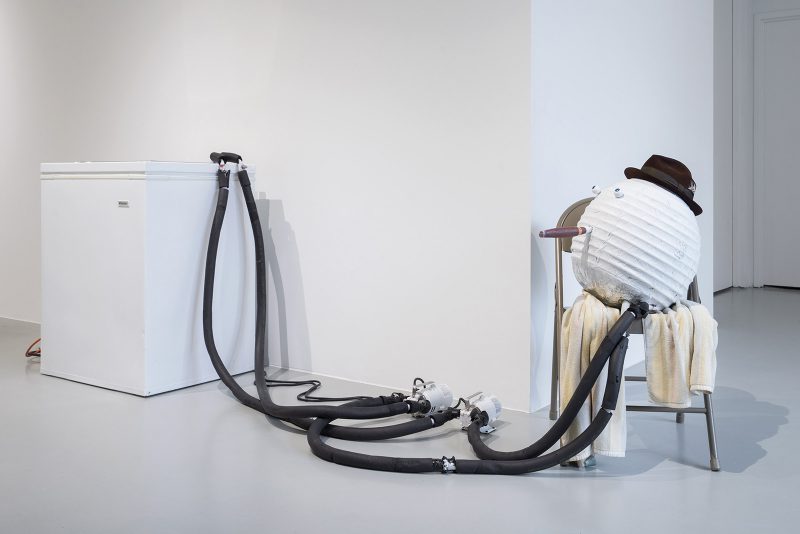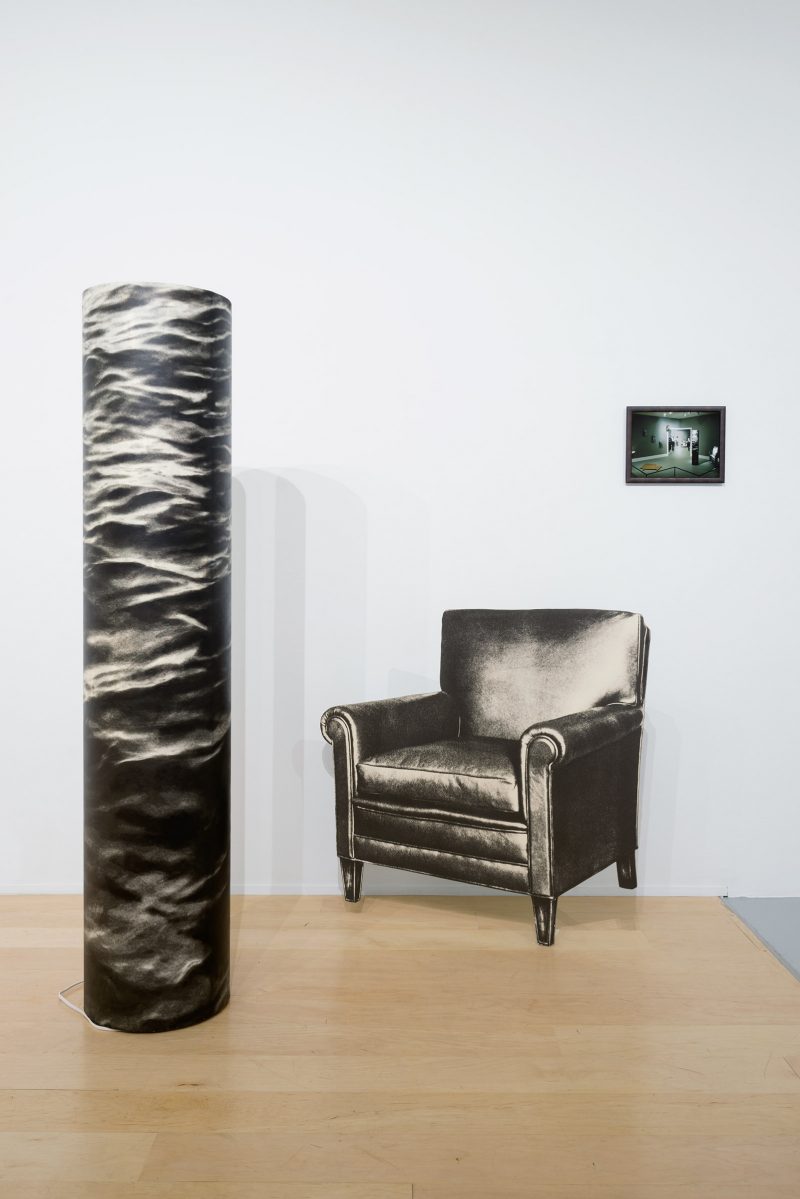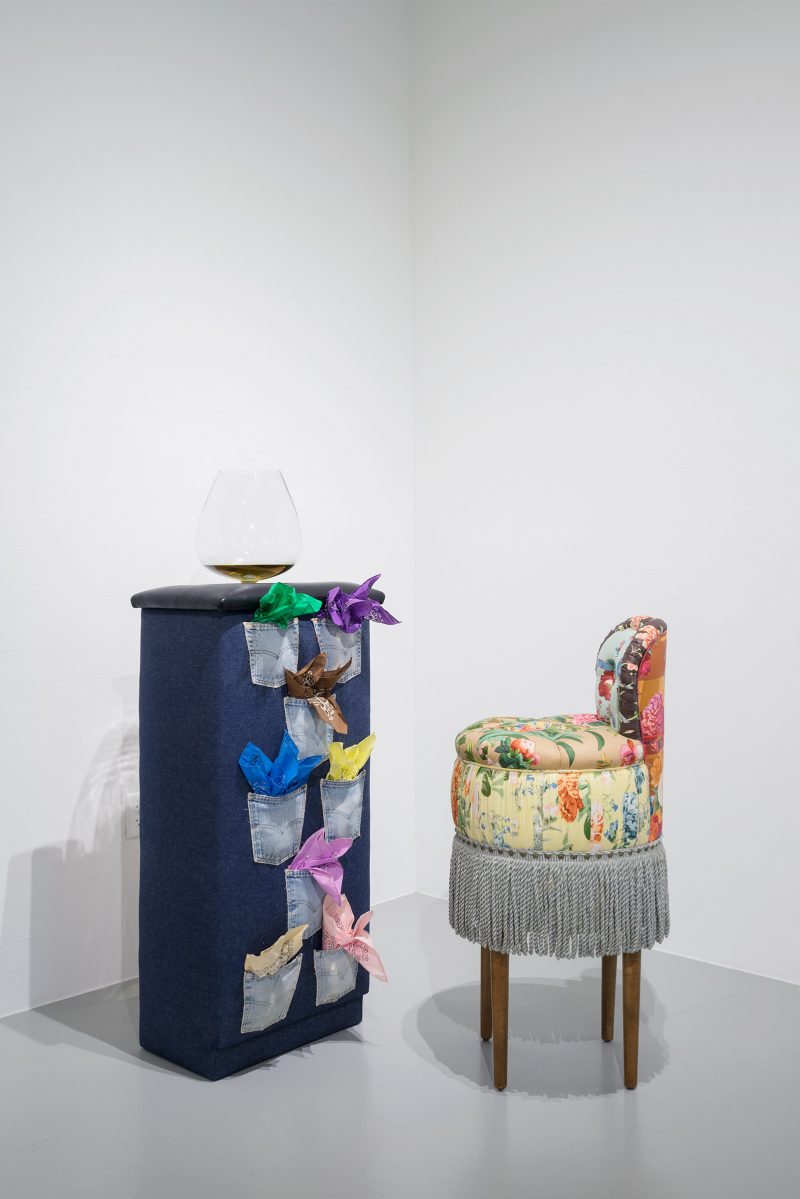Nearly any contemporary art excursion around Philadelphia in 2016 is sure to yield a wide range of styles and spectacles, but one persistent–if scruffy–thread is certainly the DIY flavor of many Philly-based artists’ work. At Rosenwald-Wolf Gallery’s exhibit Circa 1995, this commonality is not merely present, it is represented in local art-historical context through objects crafted some twenty years ago. This juncture in Philadelphia’s visual culture would help give rise not only to the ongoing careers of the artists participating in this show, but to a distinctive artist-run flavor that persists in Philly to this day.

Rough-and-ready
Perhaps no one in this show embodies the rough-and-ready aesthetic quite as completely as Tristin Lowe. Near the rear of the gallery, a baby blue mattress propped up on a folding, wooden stand lies horizontally, spewing a stream of water directly up from its midpoint. Plainly titled “The Bed,” this piece is as much mechanical handiwork as it is slapstick. Predating Tracy Emin’s “My Bed” while drawing on the cot-like combine “Bed” by Robert Rauschenberg and the comedic irreverence of “Fountain” by Duchamp, this actively bubbling apparatus warrants a chuckle and a cringe in equal parts. The ‘gag’ here is a double entendre where the mild humor of the sight quickly wanes into disgust as the water-stained fabric gives rise to more visceral feelings.

Across the room, Lowe’s “Frosty” doubles down on his technical acumen. We find a round, metallic form affixed with eyes, a hat, and a cigar staring blankly up at us from a folding chair. This piece is attached by tubes to a freezer which proceeds to encrust it in a layer of white frost. Visual comedy is again the primary hook here, for better or worse, and the disembodied snowman head inverts the popular holiday song into some sort of mechanical knock-off for future generations to enjoy in the midst of a warmer planet.
Synthetic surfaces
Eileen Neff dominates a large portion of the back space in the gallery with her photographic constructions that nod to both the domestic and the natural. “Mesa” is carved from Styrofoam, coated in a mottled, grayish black layer of paint, and topped with sandy soil. A synthetic material like this has a long future ahead of it, not unlike the geological forms it was modeled to resemble. The color scheme here is very similar to the desaturated photo elements that Neff includes elsewhere. “No Door,” which hangs adjacent to “Mesa,” appears to depict a wooden table topped with rust-colored dirt. Since ‘mesa’ means ‘table’ in Spanish and Portuguese, it is unsurprising that these two pieces mirror one another with their dusty surfaces.

In “The Midway,” Neff takes a hard look at representation by way of photos and objects. In a tall, spinning cylinder printed with the texture of choppy water, she attempts to pinpoint the overlaps between photo and object, representation and reality. Created as a response to the museum experience itself, an accompanying image of the photographic chair, water column, and even false visitors in a display area establishes an air of ambiguity. Neff seems to muse that our participation in the art viewing process is what bridges philosophical gaps. Control of meaning is ultimately ceded to the audience, and our interpretations necessarily fill in the blanks left by the artist, whether intentionally or not.
Subcultural statements
Elsewhere in the exhibit, Jennie Shanker’s “Poet” tirelessly spins on a motor, incrementally adjusting twenty-seven wheels, each of which contains the alphabet in full, plus a blank space. This automated wordsmith will churn out garbled, generative combinations of letters which, given an infinite time scale, would eventually form all possibilities of character combinations. This work is an exploration of potential as much as it is an exercise in patience.

Stuart Netsky and Virgil Marti’s “Levi/Leather Bar and Stool” provides a humorous take on the handkerchief code system used by gay men and BDSM practitioners. Here we find a physical bar (the furniture as opposed to the establishment) that is literally made out of denim and leather. While the bar’s sewn-in pockets make it appear to be down for… pretty much anything, a gigantic snifter of booze sits atop it, waiting to be imbibed; a whiff of this solution proves it is real, and probably past its expiration date. Just in front of this visual pun sits a gaudy piece of floral upholstery complete with dangling tassels, while the bar itself is just barely wide enough for a single patron. A bar for one seems to be a lonely proposition, and considering the festering glass of alcohol, no one is getting drunk either. In this light, an initially humorous piece contains themes of marginalization and struggle just below the surface.
Along with a few objects by Michael Macfeat, and a smattering of other works by the rest of the participating artists, Circa 1995 presents a vision of Philadelphia’s not-so-distant past. These artists still produce and show work, but here their older creations are demonstrated to inform the present of art making in Philly. Even when this show is a bit rough around the edges, it provides a healthy context of hindsight for much of the city’s contemporary object art.









